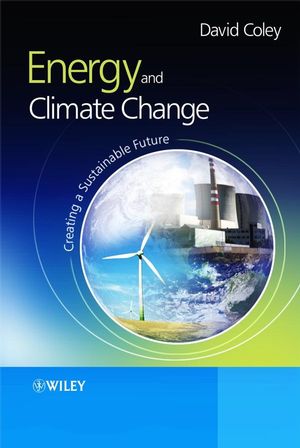Energy and Climate Change: Creating a Sustainable FutureISBN: 978-0-470-85312-2
Hardcover
672 pages
May 2008
 This is a Print-on-Demand title. It will be printed specifically to fill your order. Please allow an additional 15-20 days delivery time. The book is not returnable.
Other Available Formats: Paperback
|
||||||
1 Introduction.
PART I ENERGY: CONCEPTS, HISTORY AND PROBLEMS.
2 Energy.
2.1 What is energy?
2.2 Units.
2.3 Power.
2.4 Energy in various disguises.
2.5 Energy quality and exergy.
2.6 Student exercises.
3 The planet’s energy balance.
3.1 The sun.
3.2 The earth.
3.3 Comparisons.
3.4 Student exercises.
4 A history of humankind’s use of energy.
4.1 Energy and society.
4.2 Wealth, urbanization and conflict.
4.3 Our current level of energy use.
4.4 Student exercises.
5 Sustainability, climate change and the global environment.
5.1 Sustainability.
5.2 Climate change.
5.3 Other concerns.
5.4 Debating climate change and answering the sceptics.
5.5 The atmosphere.
5.6 Student exercises.
6 Economics and the environment.
6.1 Key concepts.
6.2 Environmental economics.
6.3 Student exercises.
7 Combustion, inescapable inefficiencies and the generation of electricity.
7.1 Combustion.
7.2 Calorific values.
7.3 Inescapable inefficiencies.
7.4 Heat pumps.
7.5 Double Carnot efficiencies.
7.6 The generation of electricity from heat.
7.7 Student exercises.
PART II UNSUSTAINABLE ENERGY TECHNOLOGIES.
8 Coal.
8.1 History.
8.2 Extraction.
8.3 The combustion of coal.
8.4 Technologies for use.
8.5 Example applications.
8.6 Global resource.
8.7 Student exercises.
9 Oil.
9.1 Extraction.
9.2 The combustion of oil.
9.3 Technologies for use.
9.4 Example application: the motor car.
9.5 Global resource.
9.6 Student exercises.
10 Gas.
10.1 Extraction.
10.2 The combustion of gas.
10.3 Technologies for use.
10.4 Example application: the domestic boiler.
10.5 Global resource.
10.6 Student exercises.
11 Non-conventional hydrocarbons.
11.1 Oil shale.
11.2 Tar sands.
11.3 Methane hydrate.
11.4 Student exercises.
12 Nuclear power.
12.1 Physical basis.
12.2 Technologies for use.
12.3 Environmental concerns.
12.4 Waste.
12.5 World resource.
12.6 Example applications.
12.7 Is nuclear power the solution to global warming?
12.8 Student exercises.
13 Hydropower.
13.1 History.
13.2 Technologies for use.
13.3 Example application: Itaipu hydroelectric station.
13.4 Environmental impacts.
13.5 Pumped storage.
13.6 Global resource.
13.7 Student exercises.
14 Transport and air quality.
14.1 Present day problems.
14.2 Air quality and health.
14.3 Example application: air quality in Exeter, UK.
14.4 Student exercises.
15 Figures and philosophy: an analysis of a nation’s energy supply.
15.1 The economy.
15.2 Production.
15.3 Consumption.
15.4 Oil and gas production.
15.5 Prices.
15.6 Fuel poverty.
15.7 Carbon emissions.
15.8 Sustainable energy in the UK: the current state of play.
15.9 Student exercises.
PART III CLIMATE CHANGE: PREDICTIONS AND POLICIES.
16 Future world energy use and carbon emissions.
16.1 The world’s future use of energy.
16.2 Student exercises.
17 The impact of a warmer world.
17.1 Climate models.
17.2 Natural variability and model reliability.
17.3 Future climate change.
17.4 Impacts.
17.5 Costing the impact.
17.6 Student exercises.
18 Politics in the greenhouse: contracting and converging.
18.1 Climate negotiations.
18.2 Another approach.
18.3 Bringing it all together.
18.4 Conclusion.
18.5 Student exercises.
PART IV SUSTAINABLE ENERGY TECHNOLOGIES.
IV.1 Current world sustainable energy provision.
19 Energy efficiency.
19.1 Cogeneration.
19.2 Reducing energy losses.
19.3 Energy recovery.
19.4 Energy efficiency in buildings.
19.5 Student exercises.
20 Solar power.
20.1 Passive solar heating.
20.2 Heat pumps.
20.3 Solar water heating.
20.4 Low temperature solar water heating.
20.5 Example application: solar water heating, Phoenix Federal Correction Institution, USA.
20.6 High temperature solar power.
20.7 Low temperature water-based thermal energy conversion.
20.8 OECD resource.
20.9 Student exercises.
21 Photovoltaics.
21.1 History.
21.2 Basic principles.
21.3 Technologies for use.
21.4 Electrical characteristics.
21.5 Roof-top PV.
21.6 Example application: Doxford Solar Office, UK.
21.7 OECD resource.
21.8 Student exercises.
22 Wind power.
22.1 History.
22.2 Technologies for use.
22.3 The modern horizontal axis wind turbine.
22.4 Environmental impacts.
22.5 OECD resource.
22.6 Example application: Harøy Island Wind Farm, Sandøy, Norway.
22.7 Student exercises.
23 Wave power.
23.1 Wave characteristics.
23.2 Technologies for use.
23.3 Example application: the Pelamis P-750 wave energy converter.
23.4 Student exercises.
24 Tidal and small-scale hydropower.
24.1 Tides.
24.2 Small-scale hydropower.
24.3 OECD resource.
24.4 Student exercises.
25 Biomass.
25.1 History.
25.2 Basic principles.
25.3 Technologies for use.
25.4 Example application: anaerobic digester, Walford College Farm, UK.
25.5 Global resource.
25.6 OECD resource.
25.7 Student exercises.
26 Geothermal.
26.1 Background.
26.2 History.
26.3 Resource and technology.
26.4 Technologies for use.
26.5 Environmental problems.
26.6 World resource.
26.7 OECD resource.
26.8 Example application: Hacchobaru geothermal power station, Kokonoe-machi, Japan.
26.9 Student exercises.
27 Fast breeders and fusion.
27.1 Fast breeder reactors.
27.2 Fusion.
27.3 Example application: JET Torus, Culham, UK.
27.4 Student exercises.
28 Alternative transport futures and the hydrogen economy.
28.1 Improving energy efficiency.
28.2 Alternative transport fuels and engines.
28.3 Hydrogen powered vehicles and the hydrogen economy.
28.4 Fuel cells.
28.5 Example application: the greening of natural gas.
28.6 Student exercises.
29 Carbon sequestration and climate engineering.
29.1 Capture technologies.
29.2 Storage technologies.
29.3 The reflection of solar radiation.
29.4 Example application: Statoil, Sleipner West gas field, North Sea.
29.5 Student exercises.
30 A sustainable, low carbon future?
30.1 Methodology and assumptions.
30.2 Results.
30.3 Worldwide reductions.
30.4 Conclusion.
30.5 What can I do?
30.6 Student exercises.
References.
Appendix 1 National energy data.
Appendix 2 Answers to in-text problems.
Appendix 3 Bibliography and suggested reading.
Appendix 4 Useful data.
Index.



